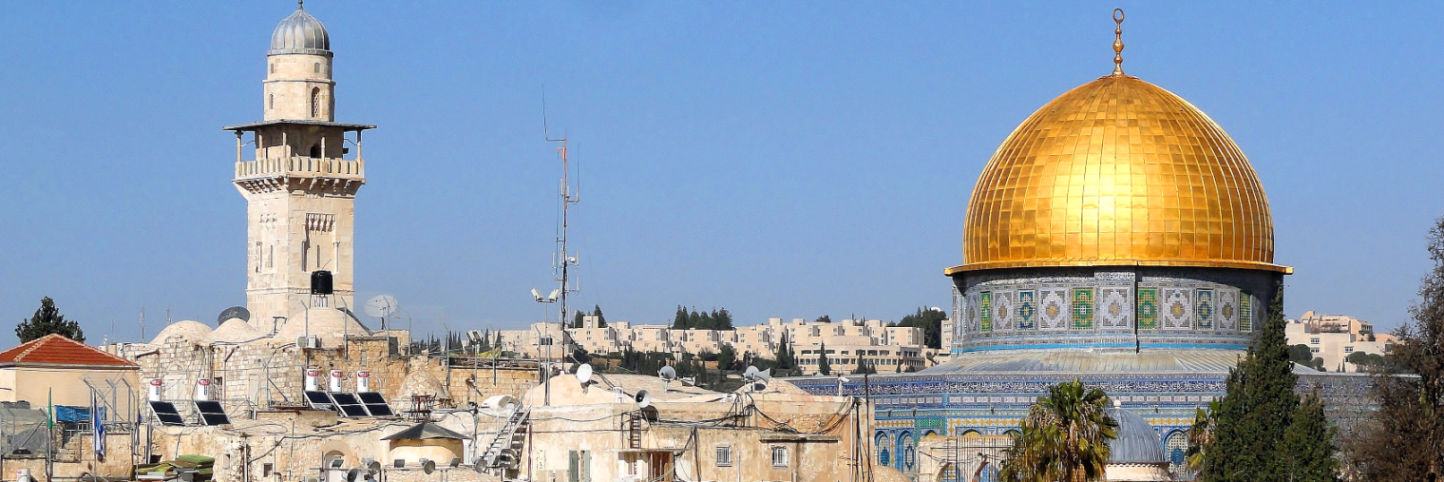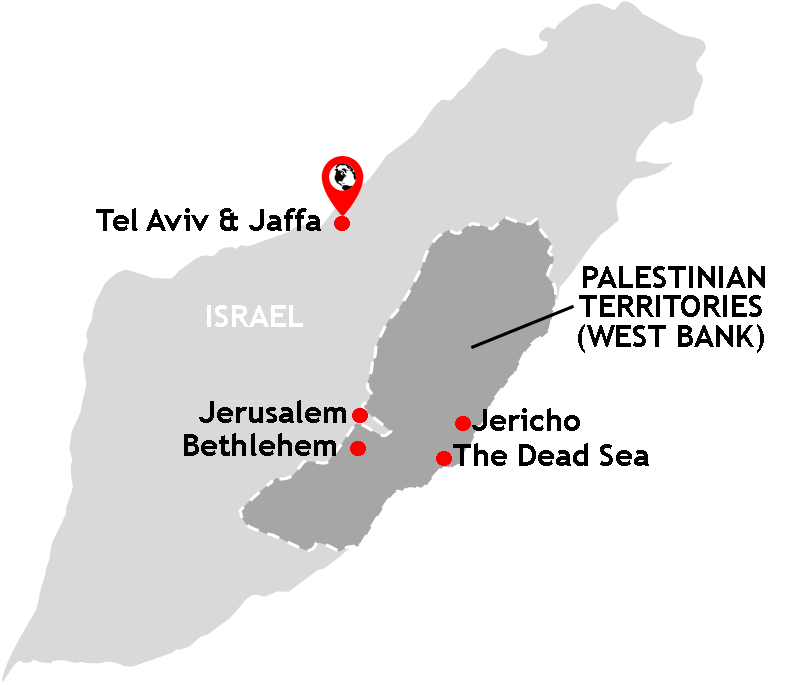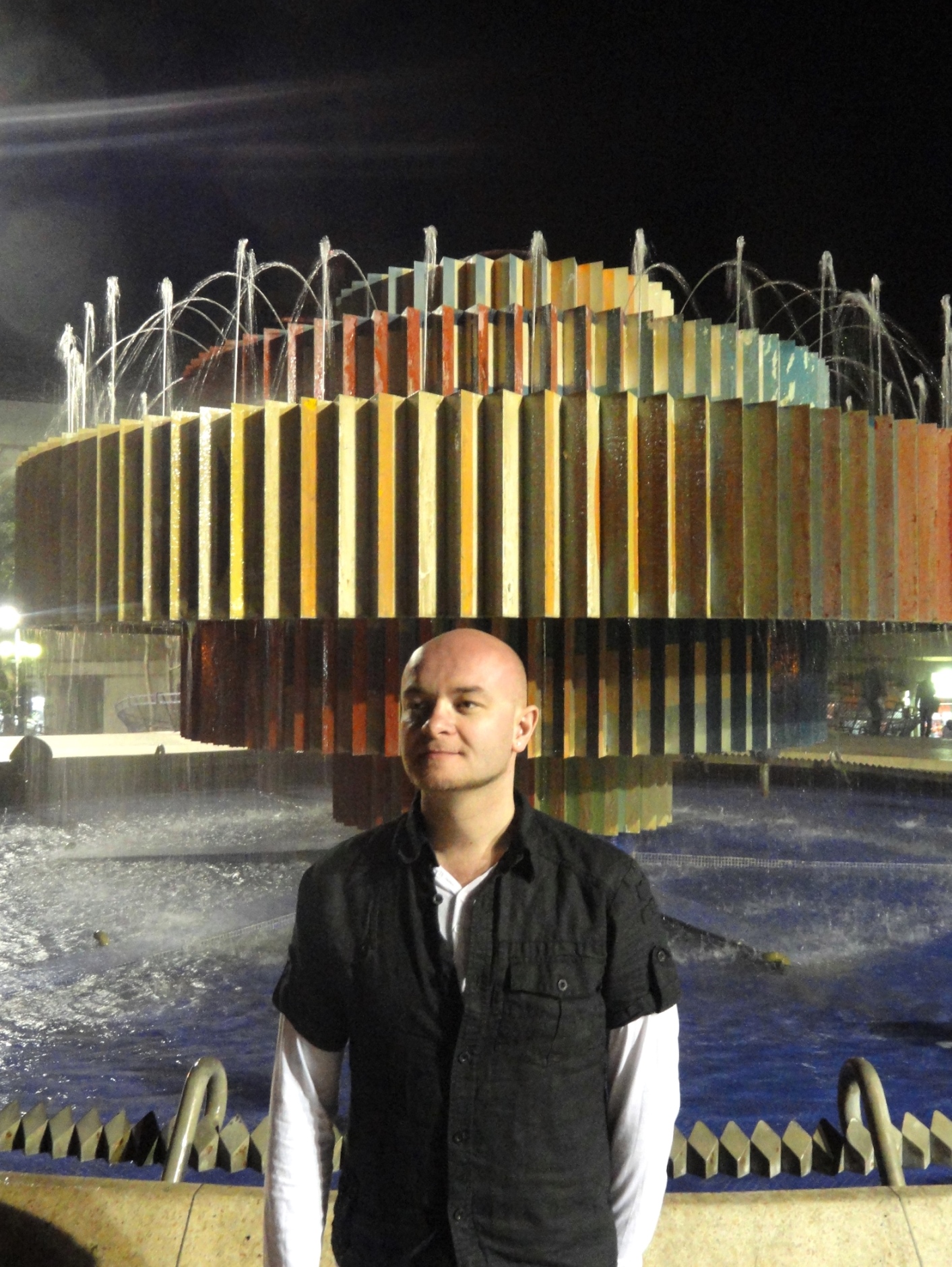
israel & palestinian territories

Where: Tel Aviv, Jaffa, Jerusalem, Dead Sea, Jericho, Bethlehem. Israel & Palestinian Territories, Middle East, Asia.
When: February 2011
What: The Dead Sea, Dome of the Rock, Western Wall, West Bank security wall, The Church of the Nativity, Oldest city in the world, Manger Square, Temptation Mountain, Israeli/Palestinian checkpoints, Touching Jesus' birth stone.
How: International flights, Hostel transfer, Walking, Taxi, Cable Car, Marashutka.
Country counter: No.31 & No.32
Illnesses or mishaps: Witnessing a rather ugly argument about religion at the Western Wall; nasty sunburn causing me to wrap a scarf around my head; finding the level of security and military presence a little too intense.
Taking advantage of reasonably-priced air fares and an impending break from work, we decided to maximise our experience in Israel by splitting it into a two-step trip commencing in Tel Aviv and heading south eastward to the world famous Jerusalem - the epicentre and point of intersection for several world religions. That was the plan but, as you'll see in this Chronicle, our trip to this culturally rich and incredible slice of the Middle East quickly spiralled into an unforgettable adventure.
israel
The Jewish Homeland
Israel is a tiny country which punches way above its weight on the world stage. Where Israel's concerned, small certainly does not mean insignificant. Israel rests high on the international consciousness; it is a place of incredible culture and people which makes this country one of the most authentic in the world. I have been to too many countries where the traveller experience feels contrived - artificial, even. In Israel, the traveller feels the raw, beating heart of a nation. I yearn for authentic experiences in travel and Israel is about as authentic a travel experience as you can get. It's a scintillating, visceral experience and, thus, in travel terms is complete travel gold. You feel Israel on your skin, smell it deep in your nose, its sounds rebounding in your ears. It's a multi-sensory experience which borders on the overwhelming.
tel aviv
Tel Aviv has long had a dangerous and exotic quality for me ever since the Gulf War of the early 1990s. Tel Aviv, frequently a target of Iraq's scud missile attacks, would often feature heavily on news bulletins in the United Kingdom, mostly characterised by terrified reporters transmitting live from apartment balconies wearing gas masks while air-raid sirens wailed. To say that this did not play a part in my decision to travel here would be disingenuous. It is because of these haunting images seen when I was a boy that I felt drawn to visit the city.
We arrived in Tel Aviv at sunset and, by the time we had disembarked from the aircraft, the city was enveloped in darkness. The first evening was thus entirely uneventful, even more so because it was Monday and most outlets seemed to be closed. I felt a little deflated. The next morning began a little more promisingly after a chance encounter with a copy of Time Out Israel. In what seemed like the fastest lift on earth, we took a trip to the top of the Azrieli Tower, affording us beautiful views out across the city. It was a dramatic and powerful vista, the white sculptural shapes of the towers set against the azure blues of the Mediterranean made for an incredibly elegant-looking metropolis. Whilst in the coastal city, we engaged ourselves in a self-guided tour of Bauhaus buildings, visited the Bauhaus exhibition, walked along the beach to Jaffa, and enjoyed a rather wonderful pinky sunset on the final evening which felt like Israel was saying goodbye.
Although I'd checked weather details before departing for Tel Aviv, the heat really took me by surprise, resorting to my hasty and expensive purchase of sun care products, soon followed by an obligatory hat purchase by the time we'd made it to Jerusalem.
The elegant view of Tel Aviv's cityscape as seen from the top of the Azrieli Observatory.
One of the three Azrieli Towers.

Dizengoff Square Fountain.
Bauhaus architecture: a key trait of the style is rounded curves.
Stunning sunset along the promenade with silhouetted watchtower.
jaffa
In many ways Jaffa is Tel Aviv's opposite. I have given Jaffa its own section as it differs markedly enough from its younger upstart a mere two kilometres further up the coast. I liked the grittiness of Jaffa, I loved its hustle and bustle, its grime, its noise and car horns, and its humble single-storied near-ruinous buildings. Evocative views greet you at the top of St Peter's Monastery. Tel Aviv gets all of the glory and attention, whilst Jaffa sits quietly waiting for you to visit with its offering of laid-back flea markets and cobbled squares.
A mosque minaret on Jaffa Hill looks out to harbour with the apartment blocks of Tel Aviv in the distance.
Lighting hangs for sale in Jaffa's flea market along Oley Tzion Street in Jaffa. Notice the trilingual sign in Hebrew, Arabic and English.
jerusalem
I am a far better traveller now than what I was when I visited Jerusalem. I didn't know what to expect and, admittedly, I was still a little green when I first stepped foot in this most holy of cities. Jerusalem has an intensity that I have experienced in very few other places. It's a frantic and intoxicating place where pilgrims and believers from some of the world's religions converge to show their devotion amid an atmosphere of unrelenting tension.
The views of Jerusalem's iconic Dome of the Rock, glittering in the burning sun, was a true sight to behold. Even the word "iconic", much overused by lazy travel writers, doesn't even come close to paying the majesty of this building. It is the kind of building which makes you feel alive; one which makes you feel like you are not just a passive onlooker ticking off a list of must-see landmarks, but are part of something far more significant. If Jerusalem is the body of world religions, then The Dome of the Rock and Temple Mount are its beating heart.
For any traveller whose mission is to travel in order to learn and understand, I suggest that there is no other place in the world quite like Jerusalem. It's an evocative, powerful, inspiring and difficult place to be,which, of course, are the most compelling of reasons to go.
Iconic Jerusalem: the alluring golden of The Dome of the Rock and its evocative blue tiling.
At the Western Wall.
Visitors enjoy the view of ancient Olive trees, circa 900 years old, in the Garden of Gethsemane.
The colourful facade of the Church of All Nations.
palestinian territories
The Palestinian-Controlled West Bank
Despite my initial impression of the Palestinian Territories being influenced by the hard-nosed, khaki-clad military personnel peering into our vehicle at the checkpoint thoroughly verifying our passports, Palestine felt remarkably different once we were away from the politics of the border itself. We had effectively crossed an 'international border' by transiting through such a checkpoint; we were now on land controlled by the Palestinian National Authority, and had unofficially 'left' Israel.
The West Bank is so-called because it resides on the left bank of the River Jordan. On entering Palestinian-controlled territory we passed road signs for "Gaza", "Hebron" and "Ramallah", place names so frequently associated with dramatic events in Western news bulletins. "This really feels like adventure travel. I'm a real traveller now", I stupidly thought to myself. I took a gulp and decided it would be circumspect to message a couple of friends as to my whereabouts and who I was travelling with. Who was this Jason, anyway? Could we trust him? How ridiculous it was to jump into the car of a complete unknown and head into a 'country' unrecognised by much of the international community. Such menacing thoughts toyed with my mind as we drove toward our first stop in the West Bank - a place I had heard about ever since I could remember: Bethlehem. Bethlehem. Bethlehem!
The West Bank was a warm-hearted place with a palpable respect for those guests who had taken the time and effort to visit this troubled land. Indeed, our guide who took us into Bethlehem was my first introduction to Palestinian people and proved to be just like all the others who followed him; respectful, dignified, calm and always commencing with the greeting, "You are welcome". It is a greeting I would come to experience in my subsequent travels across the Arab world in places as diverse as Jordan, Oman and Kuwait, to name but three.
bethlehem
Yes, I was in Bethlehem. Just being in the place I had heard about ever since I could remember was a truly visceral experience; it was the place I thought for many years was perhaps even mythical and legendary. The place I had read about in Religious Education and the place mentioned in so many of the Christmas carols I had sung as a schoolchild while waiting eagerly for Christmas Day and the opening of presents to finally arrive: donkeys, away in a manger, Mary and Joseph, no room at the inn, Bethlehem. It did exist and I was standing in the famous Manger Square at its heart.
We disembarked and were quickly handed over to a contact of our driver who lead us, by foot, on our whistle-stop tour of this most famous and holy of places. We were lead through Manger Square, stopping only to be shown a map on public display which graphically detailed the alleged shrinking in size of Palestinian land across the decades. We entered the Church of the Nativity and, like many a pilgrim, were shown the spot where it is believed Jesus was born. Touching the stone, its edges encased in silver, is a right of passage for many Christians. I only took to touching it because our guide was of the opinion that I should. Our experience of Bethlehem concluded with a visit to the large, looming grey bulk of the West Bank Wall which separates the Palestinian-controlled West Bank from Israel and which seemed to symbolise the intractable nature of the complex issues in this part of the world. Standing under the soaring, interlocking concrete panels topped with barbed wire and daubed with graffiti, I felt as far away from Mangers, donkeys and Jesus as it was possible to get.
Striking graffiti on the West Bank security wall.
At the foot of the wall on the Palestinian side.
Inside the Church of the Nativity: the opening to the area where the stone upon which Jesus was 'born' is a right of pilgrimage for Christians world-wide.
kibbutz kalya
Having headed back to Jerusalem from Bethlehem the previous day, and having decided that Jason was legitimate, we made an arrangement to head back into the Territories with him for a second time. We passed Bedouin settlements and camels in the desert to arrive at what is the world's lowest sea level point at minus 420 metres.
The sea water tasted like nothing I had ever experienced (I hadn't taken to drinking it, you understand, it was just the result of a few splashes which had landed on my lips - glad that's clear). Throwing caution to the wind, such is my predilection when in a magical place, I packed handfuls of slimy, stinking mud all over my body - a substance known to be extremely high in bromide, iodine and salt and which causes you to float in water. Unfortunately for me, it also caused my already-sunburned face to flare up with a vengeance, making my face redder and rawer than ever.
Tantalisingly, we could vaguely make out the country of Jordan in the distance... Indeed, I was to visit Jordan the following year. With obligatory mud pack donned, floating and then mud pack washed away, we pressed a little northward on to Jericho: the oldest city on the planet...
The Dead Sea is the lowest sea-level point in the world.
Dead Sea 180°.
Playing with the famous mud of the Dead Sea which later played havoc with my sunburned face.
jericho
Jericho is a rather delightful place where camels cross the road and where donkeys try to escape the fierce sunshine by leveraging the shade of giant cacti. It is a calm and tranquil city in which to contemplate what really matters in life. It also holds the accolade of being the oldest city in the world, said to be around 10,000 years old - the historical remnants of which we could see for ourselves after paying the Palestinian Authorities Department of Antiquities a few Shekels. The site included the world's first-ever tower and first-ever staircase. Jericho is also known for being the place where the sycamore fig Tree of Zachaeus, an ancient specimen mentioned in the Gospel of Luke and which, if you are a believer, you can see growing contentedly by the roadside. I am no arborist but, I can confidently assert, the tree does indeed look to be from another world altogether.
With time running out we made for the cable cars at the foot of the ancient ruins and up to the evocatively-named Temptation Mountain. There was an issue with trying to pay using my credit card at the small tourist centre, prompting the kind Palestinian lady to pull on a few favours with neighbouring vendors to complete the transaction. For her trouble I also purchased a small mosaic drum covered in goat skin and which now takes pride of place on my bookshelf at home.
Desert views of the Jericho mountains and houses as seen from on-board the cable car on the way back down from Temptation Mountain.
Nabu Musa mosque on the outskirts of Jericho.
A message of peace in two languages.
A camel calmly holds up traffic in Jericho. For obvious reasons this photograph is blurred as I struggled to capture the lolloping camel through the car window.
travel tips, links & resources
- Be careful where you point your camera, particularly in areas where security concerns are heightened or where their is significant military presence and infrastructure. It is always a little tempting to photograph checkpoints and borders but my advice is to resist the temptation.
- Be mindful of wearing shorts in some religious places as these are seen as too informal. If you're planning on visiting religious buildings, it is advisable to pack trousers and a long-sleeved shirt in your day bag.
- When travelling in Israel, particularly in places where a significant number of people gather, it is advisable to be conscious of your surroundings. The threat of attacks is real enough. Indeed, two months after our visit, a bomb was detonated in a central bus station in Jerusalem. News footage broadcast in the United Kingdom revealed it to be the station we had used ourselves.
you may also like
